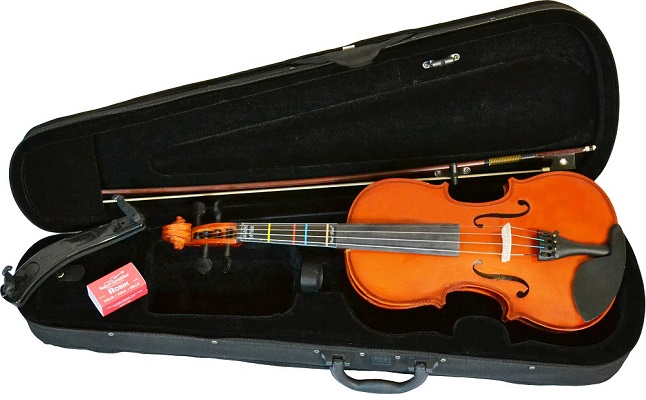Violins for Sale - How to Avoid Buying A Lemon Violin
 Searching the Internet, there are tons of violins for sale. Here’s just a few bogus points made by online violin shops:
Searching the Internet, there are tons of violins for sale. Here’s just a few bogus points made by online violin shops:- "The fingerboard, tailpiece, pegs, and chin rest are made from plastic": Violins cannot be made out of plastic, especially the tailpiece (black piece that is under the violin bridge) and pegs (black pieces at the top of the violin).
Tailpieces handle a lot of tension, so a plastic tailpiece will break, possibly hurting the violinist. Pegs made out of plastic cannot hold their pitch, causing the violin to get out of tune constantly. For beginner violinists, this is extremely frustrating since learning to play the violin is already so difficult. - "The top is made from Composite Wood": Violins cannot be made out of composite woods, since composite woods are not strong enough to keep the violin intact. Please watch this video describing the difference between a Plywood and Solid Wood Beginner Violin
- "Brazilwood Bow With Unbleached Genuine Mongolian Horsehair": We found a beginner violin for $60 on eBay that claims to include a Brazilwood violin bow. We question this claim greatly since a true brazilwood violin bow with mongolian horsehair would cost around $30. Claims like these are made since it is difficult to tell the difference between mongolian horsehair and nylon horsehair.
To elaborate further, we question why they need to lie about this. Our Model 12 beginner violin comes with a basic bow and nylon horsehair. For beginners, there’s no reason to get a violin bow with true mongolian horsehair. - "Set up and ready to play": You'll find this on almost all the violins you find online. But please know that many of these violin sellers do not setup the violin properly. For us, we go through a two-part inspection process each taking at least 15 minutes in order to ensure that every violin is ready to be played upon arrival.
Another reason we question this claim is due to the price. At only $70 including shipping, there is absolutely no way they can hire a professional for 30-45 minutes to setup the violin properly. - "The bridge can be customized by a violin luthier in order to draw out a better tone from the violin. If the bridge is not set, follow these simple instructions. First, position the bridge with higher side of the bridge under the lowest string, the G string. Tilt the bridge up under the strings toward the tailpiece and set it at a 90-degree angle. If the bridge cannot be tilted, the strings are too tight. Loosen the strings slowly and just enough to hold the bridge in place. Align the feet of the bridge with the two notches of the "F" holes and align the bridge evenly with the fingerboard. Evenly spaced out the strings on the bridge." This shop is selling their violins on Amazon and is trying to teach a beginner how to setup a bridge. We question how effective this is, since even an advanced violin player may not know how to set up a bridge. An individual who buys this violin may end up having to take the violin to their local violin shop to have them set it up. Local shops charge between $50-100 for a violin set up, depending on how much set up is needed.
 Beginner Violin |

Intermediate Violin |
